Lecture
The exercise is aimed at understanding the partner through body language. Halo effect; open and hidden body language; external posture and internal position; manner of sitting; legs as a signal of relationship to a partner; combination or mirror image. Exercise: "Choosing the right posture", "Reading thoughts on the figure," "Self-presentation through gestures." Test "Understanding the body language code."
Davies F. Your absolute image. A book for politicians and businessmen, men and women. M .: - Vneshsigma, 1997. - 302s.
Your posture
At the word "posture" we have associations with old-fashioned classes to instill good manners. In fact, your posture is your attitude towards yourself, which you show the world: how much you value yourself, how your life has treated you and how you feel in a real situation. Good posture is not the exaggerated straight bearing that is taught in the army, it is a natural line of the head and spine, a relaxed, not “squeezed” body.
Your posture is controlled by your permanent habits. If, by talking, you are used to pushing your chin forward, which is typical of an aggressive, penetrative personality, then you will soon get used to this facial expression, and you will consider it quite normal. Your spine will assume a curved position in the neck. In the same way, if you constantly slouch or stick out your chest, these poses will become habitual and natural for you.
If you had to change your posture, you would feel very strange. Your reflection in the mirror would seem alien to you, because you are used to seeing yourself as a kind of person with a certain whim. Therefore, it is difficult for us to be objective in relation to our posture.
We take over the “quirks” of our posture from our parents, but in addition our emotional state and how we adapt to physical conditions affect our posture. If most of the time you sit at a bad, in terms of ergonomics, table, on an uncomfortable chair, you have to bend the spine to get comfortable. This, of course, will have a negative impact on your posture.
Some habits develop as a result of our specific features. For example, a person with a worm in one ear tries to listen more attentively with the other ear, as a result he gets used to tilt his head in one direction. If for several years you have been wearing long hair that constantly falls on one eye, you may have developed the habit of throwing hair from your face and again tilting your head to the side. If you were shy of being too tall in your youth (many habits are formed during adolescence, when everything is perceived especially acutely), you could develop a habit of slouching, trying to appear smaller, lower to the level of other people from your environment.
Your posture depends largely on your desire to appear smaller or larger than it actually is. With your posture, you can show how “rightly” you are in one place or another, how important you consider your presence there. This is most clearly demonstrated by the postures that most of us take when trying to “behave”. We sit down symmetrically, having together legs together, having straightened the body, having folded hands on knees. If we were photographed at this moment or drew and circled the shape of our figure, this circle would turn out to be rather small. In a relaxed position, when we sit with our legs on our legs, leaning back, with our hands on the back of the chair, we look much more expansive, that is, we occupy more space, which can be clearly seen if you circle a photo of a person in this position.
We can try to change the shape of our body with an appropriate pose. The fat man, who is also hunched, involuntarily draws attention to his height. Another person of similar physique, but with a good posture, makes a completely different impression. Out of habit, you can try to hide the bulging belly, pulling in and straining it, while the upper part of your body will come forward and give the impression that it is too heavy.
The posture can be influenced by fashion and the vagaries of society. For example, the posture of a woman depends on whether she is wearing high heels or low, wearing tight-fitting clothes or a dress of free cut. At different times, different figures come into fashion. For example, in the 1950s, women with magnificent forms were in fashion; in the 1960s, fashion began for thin teenage women with absolutely unexpressed signs of gender. Your body feels differently in different clothes, and you hold on accordingly. If fashion and society advertise a certain ideal - a peace-loving hippie or a Hollywood movie star, then those who aspire to these ideals reflect these aspirations either in a relaxed manner to hold onto or folding their lips with a bow and emphasizing their breasts. Currently sporting trained figures are in fashion.
Your posture can also be an indicator of how you react to stress. In a stressful state, a person instinctively wants to either run away from stress or join in the fight against who is causing the stress. Signs of the instinct of "escape" are as follows: the head held up and thrown back, strained shoulders, and elbows pressed to the sides and foot stepping in place. The instinct of "struggle" is manifested in the fact that the head is pulled forward, the arms are bent at the elbows, the fists ready for a fight are compressed, the legs are spread shoulder-width apart in order to appear larger and, therefore, more formidable. And if these actions are repeated quite often, then they become a habit and become your permanent feature.
Thus, your posture shows, to some extent, and how you protect yourself, and sends the appropriate signals. “We fight” or “fly away” - it depends on the specific situation. Although many of us use one of these reactions more often. We do not understand that the signals formed by the “struggle” reaction, as a result of which a person looks aggressive, are formed under the influence of the feeling that he is threatened.
Your posture reflects the aging process. The more you learn bad habits, especially the style of hunching the older you look. Poor posture also negatively affects your health: if your spine is curved, you may have back pain and will not lead to anything good, whether your internal organs are crushed for several hours in a row. If you hunch, then look tired and exhausted.
You can change your posture and identify those habits that send powerful signals that harm our way of holding. If you want these signals to be perceived differently, you should work on it. If you identify your stressful areas, you can relieve tension from them. When we can control our physical symptoms of stress, it is possible that the level of our tension will decrease, because the brain will not receive signals confirming this condition. And, of course, other people will not be able to notice that we are nervous. As a result, we will regain confidence.
Posture Exercises
Do these exercises if:
• you need to improve your overall posture;
• in a tense situation or when the student is looking at you and “shrinking” or “swelling up” due to physical exertion;
• you are nervous, you feel a physical shiver.
1. Standing on the toes, hands hang loosely on the sides, slowly sink to the heels, while slightly leaning forward (about 2/3 of the toes of the toes). Sinking down on your heels, try to keep feeling that you are tall and keep your balance well. At the same time, imagine that you, like a puppet, hang from a rope tied to your crown, and this rope is pulled upwards.
2. Stand with your back to the wall, leaning against the back of her head, shoulders, pelvis and heels. Relax and balance your body in this position. Then move away from the wall, trying to maintain a feeling of elongation in the spine and head.
3. Deliberately hunch, so that the ribs go inside, and the shoulders are rounded. Then straighten and straighten, feeling taller and wider. Shake your arms and legs to relieve tension, make sure your elbows, knees and ankles are relaxed.
4. In the sitting position, try to sit as close as possible to the back of the chair, clinging to her lower back.
Pease A. Body Language. How to read the thoughts of others. - M .: Izd0vo Eksmo, 2002. - 224 p. (Success Psychology Series.)
Gestures, sets of gestures, postures and circumstances used in everyday communication
Figure 1. An example of an open set of gestures. The palms are fully open, the position of subordination, the fingers are spread apart, which gives the gesture additional expressiveness. Head in neutral position, arms and legs apart. The person expresses a submissive, non-threatening attitude towards the interlocutor.
Figure 2. The classic gesture of deception. Rubbing his eyes, the man looks at the floor, his eyebrows raised in a gesture of distrust. The head is turned away from the interlocutor and lowered, which indicates a negative attitude. In addition, an insincere, tense smile plays on his lips.
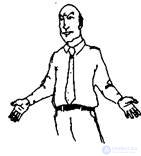 Picture 1
Picture 1 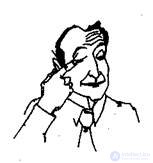 Figure 2
Figure 2
Figure 3. In this picture we see incompatible gestures. The man smiles confidently, crossing the room, but one of his hands overlaps the body to adjust the clock, thereby forming a partial barrier. This tells us about his inner uncertainty.
Figure 4. This woman clearly disapproves of the person she is looking at. She didn’t turn his head or body in his direction, but she looked askance at him with her head slightly bent (disapproval), her eyebrows knelt a little (anger), her arms were completely crossed (defensive position), and the corners of her mouth were lowered.
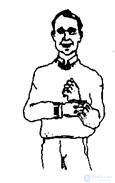 Figure 3
Figure 3 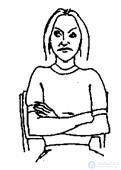 Figure 4
Figure 4
Figure 5. Domination, superiority and protection of the territory. The hands behind the head speak of self-confidence of the man, and the legs on the table demonstrate territorial claims. To emphasize his status, he uses a swivel chair with a reclining back and wheels. In addition, he sits in a defensively competitive position.
Figure 6. Hands laid on. thighs This girl obviously wants to look older and more militant. The chin is pushed forward, showing the challenge, the mouth is open - you can see the teeth, well, than the animal that did not grin!
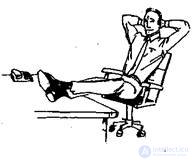 Figure 5
Figure 5 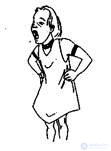 Figure 6
Figure 6
Figure 7. This set of gestures can be described in one word - negative. The folder is used as a barrier, arms and legs are crossed to hide nervousness or defensive mood. The jacket is buttoned at all buttons, and dark glasses hide eyes and make it impossible to recognize the signals of the pupils. Most of this man’s face is hidden by a beard, making him look suspicious. Knowing that 90 percent of the impression of a person is created in the first half minutes of communication.
Figure 8. Both men use gestures of aggressiveness and readiness. The man on the left put his hands on his hips, and the one on the right placed his thumbs on the belt. The man on the left is less aggressive, as he leaned back and his body was turned away from the interlocutor. Nevertheless, the man on the right took a threatening pose, he turned to face the other person. The expression on his face only confirms his gestures.
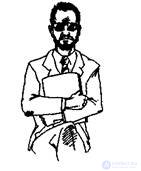 Figure 7.
Figure 7. 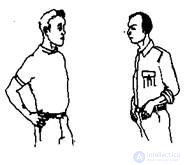 Figure 8.
Figure 8.
Figure 9 . The man on the left straddled the chair, trying to control the discussion or dominate the man sitting to his right. In addition, he turned to face the man on the right. He clutched his fingers and joined his legs under a chair, which indicates his anxiety. Perhaps he is unable to convince interlocutors to accept his point of view. A man sitting in the center feels superior. This conclusion can be made by noting that he laid his hands behind his head. In addition, he folded his legs into the lock, which indicates his disagreement and intention to argue. His swivel chair with wheels and armrests also enhances its status. The man on the right is sitting in a chair that lowers his status, since his legs are fixed and he has no accessories. The hands and legs of this man are tightly crossed (defense), his head bowed (hostility), which means that he does not believe in what he is being told.
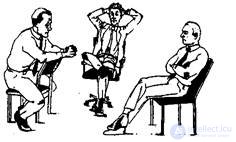 Figure 9.
Figure 9.
Figure 10. The woman depicted in this figure demonstrates the classic courting position. She pushed one leg forward in the direction of the man standing on the left (interest), the hand was placed on the hip, the thumb was laid in the belt (sexual readiness), the left wrist was exposed, the cigarette smoke was directed to the ceiling (confidence, positive attitude). rank, and he responds to her courtship, straightening his tie (preening) and putting his foot toward her. A man standing in the center is clearly not happy with the presence of an opponent, as his body is turned away from him. In addition, the man in the center looks askance at his neighbor aggressively. He exhales smoke down (negative attitude). The man in the center leaned against the wall (territorial aggression).
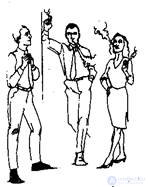
Figure 10
Figure 11. The man on the left uses gestures of excellence and is clearly arrogant about the man sitting opposite. His eyes are half closed, he tries not to see his interlocutor. The head is thrown back, which creates the impression of a “raised nose”. Defensive mood is also given by his knees, tightly moved together. He holds the glass with both hands, which forms a barrier between him and the interlocutor. The man in the center does not participate in the conversation, since the other two do not form a triangle that includes him in the conversation. However, this does not depress him, since he laid his thumbs in the pockets of his vest (superiority), leaned back in his chair and spread his legs. His head is in neutral position. The man on the right is fed up. He is sitting in the starting position (ready to leave), his legs and body are directed to the exit. Eyebrows and corners of the mouth lowered, head slightly tilted. A man with all his appearance shows disapproval.
Figure 12 . The man on the left and the man on the right form a closed position to show a person standing in the center that his presence is undesirable. However, those who stand in the center clearly feel their superiority and sarcasm. He took the lapel of his jacket, with the thumb pointing upwards (excellence), with the thumb of his other hand he points to the man standing to his right (ridicule), who took a defensive position, crossing his legs and clasping his forearm with one hand with the other arms). He looks at the man in the center of the squint. The man on the left is also not happy with the presence of the third. He crossed his legs (defense), put the palm of one hand in his pocket (unwillingness to participate) and looks at the floor, rubbing his neck with his second hand.
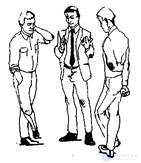 Figure 11
Figure 11  Figure 12.
Figure 12.
Figure 13 . The atmosphere in this picture is also quite tense. All three interlocutors sit in their chairs as far as possible from each other. The man on the right is the source of the problem, as we see a negative set of gestures. During the conversation, he rubs his nose (deception), his right hand covers the body, forming a partial barrier (defense). He is not sure of the reaction of the interlocutors, which is noticeable by the way he put his foot on the arm of the chair - it is directed from the interlocutors. The man on the left clearly does not approve of what he hears, as he shakes off imaginary villi from his jacket sleeve (disapproval), his legs are crossed (defense) and sent to the side (disinterest). The man in the center would like to say something, but is holding back. This is noticeable by the way he grabbed the armrests of the chair and clasped his feet. He turned to the man sitting on the right, which speaks of a non-verbal challenge.
Figure 14. In this picture we see that the man on the right and the woman on the left copy each other's gestures. The couple is clearly interested in each other: their hands are located so that their wrists are visible, in addition, they crossed their legs and directed them to each other. The man sitting in the center smiles tightly, showing his interest in the words of the man on the left, but his expression and gestures indicate the opposite. His head is tilted (disapproval), his eyebrows are lowered (disgust), he glances at his neighbor sideways. In addition, his arms and legs are tightly crossed (defense). His mood is clearly negative.
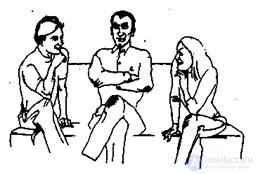
Figure 13.

Figure 14.
Figure 15 . The man on the left shows a wonderful set of gestures that speak of honesty and openness - open palms, his leg is set forward, his head is raised, his jacket is unbuttoned, there is a smile on his face. Unfortunately for him, the interlocutors are not delighted with him. The woman lay back and crossed her legs, sending them to the side (defense).She formed a partial barrier with her hands (defense), clenched her fist (hostility), lowered her head and raised her hand to her face (critical evaluation). The man in the center folded his fingers, which indicates a sense of superiority and self-confidence. In addition, he folded his legs into the lock - competitive mood, willingness to argue. His mood is rather negative, as he sits with his head lowered.
Figure 16. All three crossed their arms, two crossed their legs (defense), and all three turned away from each other. You can decide that they met for the first time. The man on the right is clearly interested in the woman - he put one leg in her direction, glances at her sideways, raising his eyebrows (interest), and smiles. He leaned slightly in her side with his upper body.
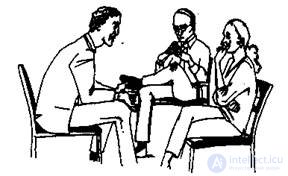
Figure 15.
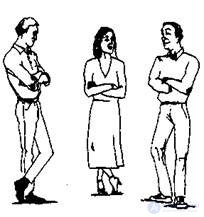
Figure 16.
Figure 17. Non-verbal relationships have changed. The woman straightened her legs and took a neutral position. The man on the left also straightened his legs and put one foot in the direction of the woman (interest). He laid his thumbs on the belt that worries the second man, as this is a sign of aggression. A woman regards this gesture as a sexual signal. The man on the left straightened up to look taller. The man on the right is concerned about the opponent’s behavior. He straightened and tensed, glancing at the second man squinted out from under lowered eyebrows (disapproval). The smile faded from his face.
Figure 18. Now the attitudes and emotions of all three have become completely clear. The man on the left continues to hold his thumbs behind the belt, his leg is exposed in the direction of the woman, the body is slightly turned in her direction. The totality of courtship is evident. Thumbs more tightly wrapped around the belt, posture has become even more straight. A woman accepts courtship and shows her interest. She straightened her arms, turned in his direction and put one foot in his direction. In addition, she straightens her hair, demonstrates her wrist and smiles. She releases cigarette smoke to the ceiling, which speaks of her confidence. The man on the right is unhappy that he was excluded from the conversation. He put his hands on his hips (aggressive readiness) to demonstrate his displeasure. Summing up, we can say that the man on the left has achieved the attention of a woman,and the man on the right will have to look for another partner.

Figure 17
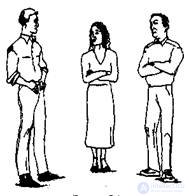
Figure 18
Comments
To leave a comment
Kinesika
Terms: Kinesika